By 5:45 AM I was sitting on the dark beach, meditating while awaiting the sunrise. To my left a skinny young Thai man jogged the tide-washed shoreline. To my right another man, clad only in surfer trunks, lay on his back with his arm over his eyes, his long tangled hair splayed out behind him on the sand, passed out after a long night of partying. The sun peeked over the limestone cliffs at 6AM, slowly turning the ocean and sky vivid shades of pink, gold, and bronze.

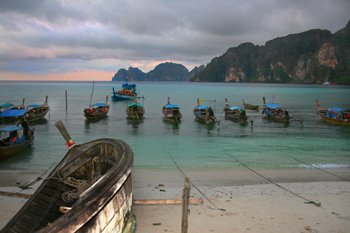
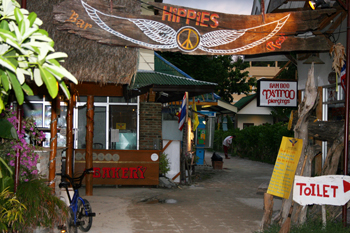
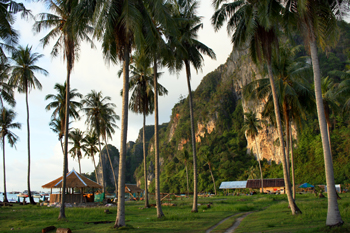


I walked along the beach, taking photos in the saturated dawn light and wandered around Ton Sai Village, nearly deserted at this hour save for a few merchants yawning and stretching as they opened their shops. Passing the municipal pier where we arrived three days ago, I continued westward to a less populated part of the island, where palm trees still abound at the feet of towering Karst limestone cliffs. At the end of the beach I cut inland and crossed the 300-foot wide isthmus that separates Ton Sai Bay from Loh Dalam Bay (see map below). The tsunami wreaked havoc here in December of 2004, approaching from the Loh Dalam Bay side and overwashing the narrow isthmus to exit on the Ton Sai side, destroying everything in its path. Although much of the village has been rebuilt there are still signs of the devastation wrought by the storm: huge sewer pipes lined up in a swath of a no-man’s land where not a blade of grass grows to this day, dead palm tree trunks tossed around a field like God’s pick-up sticks, and piles of debris choking river beds and underlying newly constructed palm thatch huts. I walked along the white sands of Loh Dalam Bay until I reached the end of this beach as well, in search of the stairway that would lead me up the mountain for a bird’s eye view of the twin bays.

Picking my way through the narrow cobblestone streets on the backside of town I finally found the stairway. The sign said “Viewpoint” with an arrow pointing up, so up I went. And up. And up. And up some more. At step number 322 the stairway ended and a steep, narrow concrete path continued up for another half mile. By this time I was covered in sweat from head to toe and struggling to catch my breath but I was determined to make the summit. Just as I thought I was going to die from the heat and humidity I crested the final hill and was rewarded with a spectacular view of the crescent bays that border the island’s narrow isthmus. The sight was especially rewarding because I arrived on foot rather than in a car on some sanitized road through a National Park. I had to work to get here and I was pretty proud that I had persevered.
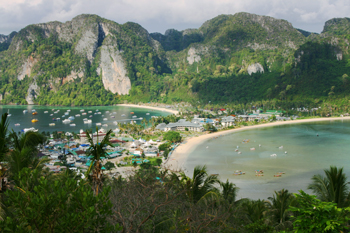
Speaking of cars, since there are no roads on this island there are no cars. I have seen three or four motorbikes – even one with a sidecar attached – but the main modes of transportation are boats and bicycles. Boats run the gamut from ferries to private yachts to speedboats to the ubiquitous longtail boats, decorated in multi-colored prayer flags. The bicycles are all older models and kids and adults alike zip around town on them, climbing off to walk up the one hill found along the harbor, then remounting to coast down the other side. None of the bikes have bells so the riders shout “Ding-Ding!” as they approach you from the rear. I am constantly hopping from one side to the other to avoid speeding bicycles, since there seems to be no rhyme or reason to the flow of traffic on the island.

As there is no airfield either, all goods arrive by boat. All merchandise is off-loaded by a cadre of men who wade out to the boat and carry it to shore on their shoulders. In the photo below the men are carrying gravel for concrete from the ship to the shore, one bag at a time. It certainly made me appreciate the work that went into building those 322 steps up to the viewpoint. Once on shore, the various goods are moved about the island either by hand or on large two-wheel carts constructed of steel pipe.

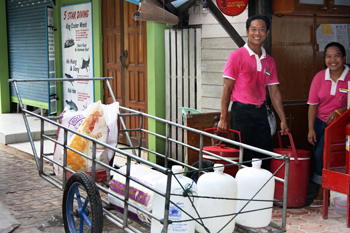
The people who live on this island are not as friendly as the Thais in Bangkok, perhaps because the of abuse that they have to put up with from drunken tourists. They do not smile easily and seem aloof much of the time, so I made it my mission all day long to see how many smiles I could elicit from the locals by smiling broadly at them and saying”Sawadee Ka,” which is the common Thai greeting, and Wai-ing to them (bowing slightly with my hands pressed together in front of my heart). Most hesitated at first but I continued to smile until they rewarded me with a big smile and a Sawadee Ka (for women) or Sawadee Krap (for men) in return.

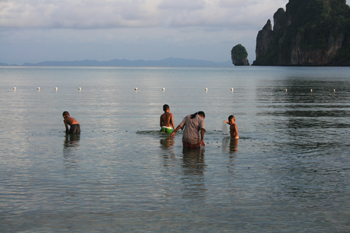
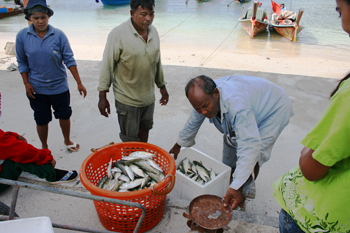
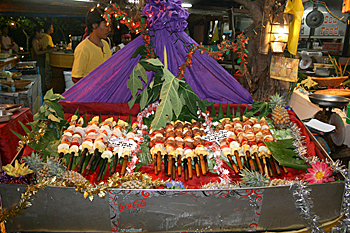

Were it not for the tourists the locals would lead an idyllic life. They rise early and sweep out their modest houses before the heat of the day sets in. Many fish on a daily basis, like this family pulling in a catch with a net. Others buy fresh fish the moment it is hauled in, the fishermen slapping a crate full of fish on a rusty old scale to determine the price. By the time midday rolls around the heat is sweltering. Shopkeepers retire to hammocks tied to trees along the sidewalks and fishermen retreat to their homes for afternoon siestas. Those who must work through the afternoon move slowly. Later in the day, when the heat dissipates, the town livens up once again. By early evening restaurants are competing to see who can lure the most customers with their yummy displays of fresh seafood. Neon signs atop storefronts and miniature lights strung through the trees create a whirl of color along the sidewalks. A cacophony of reggae-country-folk-rap music blares from dozens of open-air bars while locals and tourists alike stroll the path along the seawall. While I still think this island is exquisite, I wish I had seen it 20 years ago, when it was still a sleepy little fishing village.

WOW! You are blessed. It is hard to keep up with your journey.
Barb, I read wide-eyed and jealous of your journey! The interesting food, the sun kissed Earth, the experience! And all I can offer back is a grateful “thank you.” Namaste, my friend.